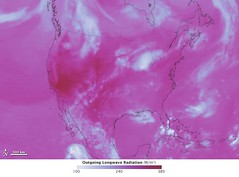 |
| U.S. Heat Wave and Earth’s Energy Balance (Photo credit: NASA Goddard Photo and Video) |
Are heat warning systems effective?(10 page pdf, Ghasem (Sam) Toloo, Gerard FitzGerald, Peter Aitken, Kenneth Verrall and Shilu Tong, Environmental Health, Apr. 5, 2013)
Today we review an analyses of a number of case studies or reports on the effectiveness and cost of “heat warning systems” (HWS) or “heat health warning systems” (HHWS). Those studies which had cost benefit estimates showed that having an effective warning system more than pays for itself. Further, the main factor that prompted the public to take action was the perceived threat of a heat wave which would encourage agencies responsible for public warnings (such as the national meteorological service) to improve how they communicate the warnings. Underlining the need to improve heat warning is the greater frequency of heat waves, as climate warming proceeds, especially in large cities where there may be twice or triple the number experienced now.
Key Quotes:
“Heatwaves kill thousands of people around the world each year. In addition, more adverse health conditions including heat-related illnesses (e.g., heat stroke, dehydration, acute myocardial infarction) and heat exacerbated illnesses (e.g., renal disease, ischaemic heart disease and mental health disorders) are associated with heatwaves”
“With higher frequency of heatwaves projected to occur as a result of climate change [12], locally tailored action plans are implemented in many affected areas to minimize harm to those most at risk.”
“One study also estimated the costs of running heat warning systems at US$210,000 compared to the US$468 million benefits of saving 117 lives.”
“Perceived threat of heat dangers emerged as the main factor related to heeding the warnings and taking proper actions.”







No comments:
Post a Comment